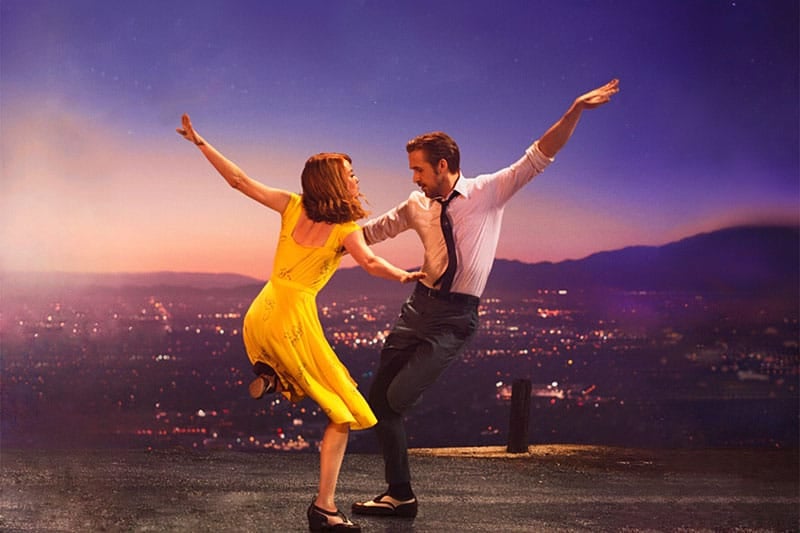When Moonlight won Best Picture at Sunday’s Academy Awards, it was an upset: La La Land was predicted to sweep the night away – including a win for Best Picture – and for a split second, America thought it did.
Now, I think Moonlight was the Best Picture this year, and was proud that the Academy thought so, too. But La La Land received fourteen Oscar nominations and six wins. Said simply, America loved La La Land because of its charm. It managed to romanticize traffic-filled freeways, smoggy views from Griffith Observatory, and young actors and musicians trying to make it in a city overflowing with talent.
But that description suggests La La Land is a superficial feel-good movie. Is there anything in the film that draws us from entertainment to deeper reflection? Does the film have more depth to be explored? I want to suggest its charm and nostalgia point us towards gratitude.
***
For much of the film, we think that La La Land will follow the standard Rom-Com:
- Boy meets Girl.
- Boy and Girl fall in love.
- Life appears like it will be happily-ever-after. But it’s an unsustainable, wild dream.
- Drama ensues and Boy and Girl break up.
- But, in a moment of serendipity, fate brings Boy and Girl back together.
- And thank God, Boy and Girl live happily-ever-after. The end.
This is something different. Beyond the charm of a typical rom-com, La La Land evokes a longing for a nostalgic past. Sebastian wants to bring back the lost art of jazz by opening a jazz club. Mia aspires to be a Hollywood actress. Mia and Sebastian meet and fall in love. Typical. After they struggle together to fulfill their dreams, they have a fight. Believing her acting career is over, Mia returns to her parent’s home. We see her bedroom – covered in middle school and high school awards. We watch her ache for a time when she felt like a successful actress. Sebastian drives to Nevada to tell her she’s received an offer to make her first feature film in Paris. They’re back together. So far, so good.
They look out onto that glamorous city of stars from a vista at Griffith Park. Standing above their city of stars, they nostalgically remember the good times they had together, and then say goodbye.
They realize that perhaps, though they love each other, their dreams are propelling them in different directions. It is time for Mia to go to Paris to fulfill her acting dream. They must choose between careers and love, and they choose careers.
But this is a superficial feel-good movie, right? As their farewell scene ends, we just know that somehow they’ll get back together.
The film fasts forward. It’s five years later, and Mia is a successful actress. Sebastian has opened his long-hoped for jazz club – named Seb’s, the name Mia suggested for him. We’re waiting to see them together.
The scene shifts to Mia’s elegant home. She comes home from work to greet her child and nanny. We’re waiting for Sebastian to give her a welcome-home kiss. And then we see Mia, poignantly, has married someone else.
* * *
What makes the film memorable isn’t the charm. It’s the nostalgia scattered throughout the film, but culminating in the final scene. Mia and her husband David, out for their dinner date, end up in Seb’s by chance. She realizes it’s his club. Sebastian gets on stage and their eyes meet. And we all experience together – that moment when they wonder, what might have been.
In a beautifully shot ten-minute musical number, we see a glimpse of what could have been – if everything would have worked out as a perfect romantic comedy. But it’s a dream of another time, of what could have happened, of nostalgia for a love lost and a different path taken.
As David and Mia walk out of the club, she and Sebastian make eye contact one last time. Without speaking to one another, they say a final goodbye. Like that final moment between Whitney Houston and Kevin Costner in The Bodyguard, their goodbye is more sweet than bitter. Whether or not they’ll always love each other is unclear. Perhaps, they’ll hold onto the fondest moments, often seeing one another in their wildest dreams.
Both Mia and Sebastian are better people today because of each other. And it’s clear they both know it and are grateful: Mia smiles slightly and walks out. Sebastian recognizes he’s grateful too, and begins to play the next song.
Whether it makes it worthy of a Best Picture or not, that’s the deeper meaning of La La Land. It doesn’t tackle racial inequity, sexual difference, or psychological trauma. But it does invite us to find gratitude in the path we’re on, especially when we’re confronted again with a lost someone or something. We can re-remember those moments with fondness and not sadness, with gratitude and not avarice. We can see that our lives have unfolded the way they have and there’s no other road. What we have is good enough.
***
Image courtesy FlickrCC user Jazzuality dot com.


